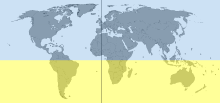
Back Suidelike Halfrond Afrikaans Sūðerne Healftrendel ANG نصف الأرض الجنوبي Arabic ܩܫܬܐ ܬܝܡܢܝܬܐ ܕܐܪܥܐ ARC نص جانوبي د لأرض ARY Hemisferiu sur AST Cənub yarımkürəsi Azerbaijani گونئی یاریم کوره AZB Habagatan na Emisperyo BCL Паўднёвае паўшар’е Byelorussian


The Southern Hemisphere is the half (hemisphere) of Earth that is south of the Equator. It contains all or parts of five continents[1] (the whole of Antarctica, the whole of Australia, about 90% of South America, about one-third of Africa, and some islands off the continental mainland of Asia) and four oceans (the whole Southern Ocean, the majority of the Indian Ocean, the South Atlantic Ocean, and the South Pacific Ocean), as well as New Zealand and most of the Pacific Islands in Oceania. Its surface is 80.9% water, compared with 60.7% water in the Northern Hemisphere, and it contains 32.7% of Earth's land.[2]
Owing to the tilt of Earth's rotation relative to the Sun and the ecliptic plane, summer is from December to February (inclusive) and winter is from June to August (inclusive). September 22 or 23 is the vernal equinox and March 20 or 21 is the autumnal equinox. The South Pole is in the centre of the southern hemispherical region.
- ^ "Hemisphere Map". WorldAtlas. Archived from the original on 22 April 2021. Retrieved 13 June 2014.
- ^ Life on Earth: A - G.. 1. ABC-CLIO. 2002. p. 528. ISBN 9781576072868. Archived from the original on 22 January 2023. Retrieved 8 September 2016.